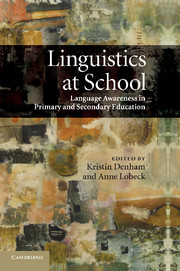Book contents
- Frontmatter
- Contents
- Notes on contributors
- Foreword: The challenge for education
- Introduction
- Part I Linguistics from the top down: encouraging institutional change
- Part II Linguistics from the bottom up: encouraging classroom change
- Part III Vignettes: voices from the classroom
- Introduction to Part III
- 16 And you can all say haboo: enriching the standard language arts curriculum with linguistic analysis
- 17 Code switching: connecting written and spoken language patterns
- 18 A primary teacher's linguistic journey
- 19 Why do VCE English Language?
- 20 Language lessons in an American middle school
- 21 The diary of Opal Whiteley: a literary and linguistic mystery
- 22 Using the Voices of North Carolina curriculum
- 23 A-level English Language teaching in London
- References
- Index
22 - Using the Voices of North Carolina curriculum
Published online by Cambridge University Press: 04 August 2010
- Frontmatter
- Contents
- Notes on contributors
- Foreword: The challenge for education
- Introduction
- Part I Linguistics from the top down: encouraging institutional change
- Part II Linguistics from the bottom up: encouraging classroom change
- Part III Vignettes: voices from the classroom
- Introduction to Part III
- 16 And you can all say haboo: enriching the standard language arts curriculum with linguistic analysis
- 17 Code switching: connecting written and spoken language patterns
- 18 A primary teacher's linguistic journey
- 19 Why do VCE English Language?
- 20 Language lessons in an American middle school
- 21 The diary of Opal Whiteley: a literary and linguistic mystery
- 22 Using the Voices of North Carolina curriculum
- 23 A-level English Language teaching in London
- References
- Index
Summary
Ms. Fields-Carey:
Before I taught the Voices of North Carolina curriculum for the first time, I worried that my students would not be interested in the study of linguistics. Sure, as a Language Arts teacher, the subject was fascinating to me, but I had no idea if my 9th graders would be able to comprehend the subtleties that studying linguistics entails, or be interested in such minutiae as which words in Southern United States dialects can adopt an “a-” prefix and which cannot. As the unit progressed, I realized that not only had I underestimated the students' ability to understand the material, I also had no idea how fascinated they would become with the study of dialects.
The region of the Southern United States in which my students and I live is growing rapidly. Over the last several decades, as technology industry growth has expanded, the area has seen a tremendous influx of people from many other parts of the country. Consequently, the character of the South is changing: what used to be small, insular communities into which people were born and which they rarely left are now becoming far more multicultural and fluid. Media such as the Internet and cable television are making many communities in the South much less isolated and traditional. Additionally, the enormous increase in the Hispanic population in our area in recent years has wrought great changes in the community.
- Type
- Chapter
- Information
- Linguistics at SchoolLanguage Awareness in Primary and Secondary Education, pp. 272 - 276Publisher: Cambridge University PressPrint publication year: 2010
- 3
- Cited by



